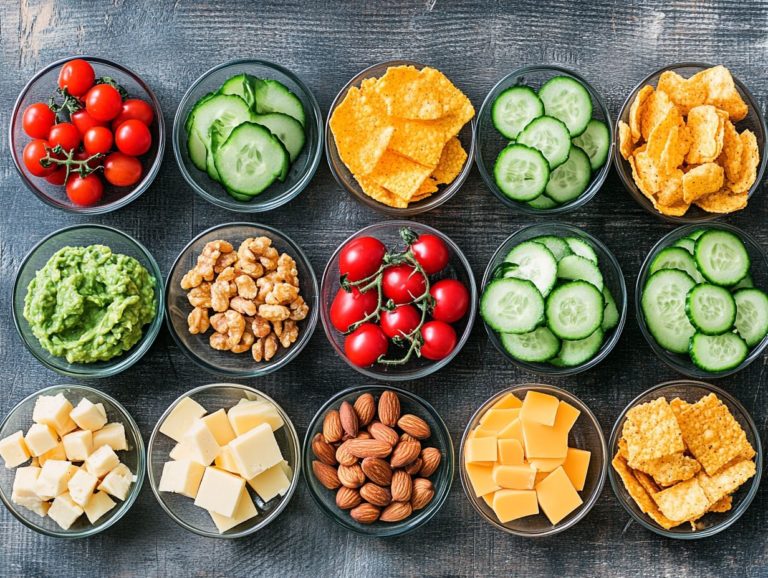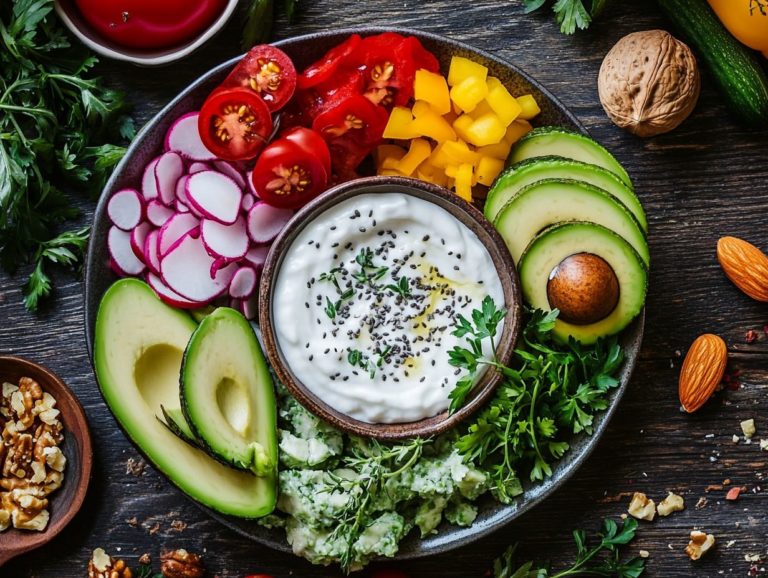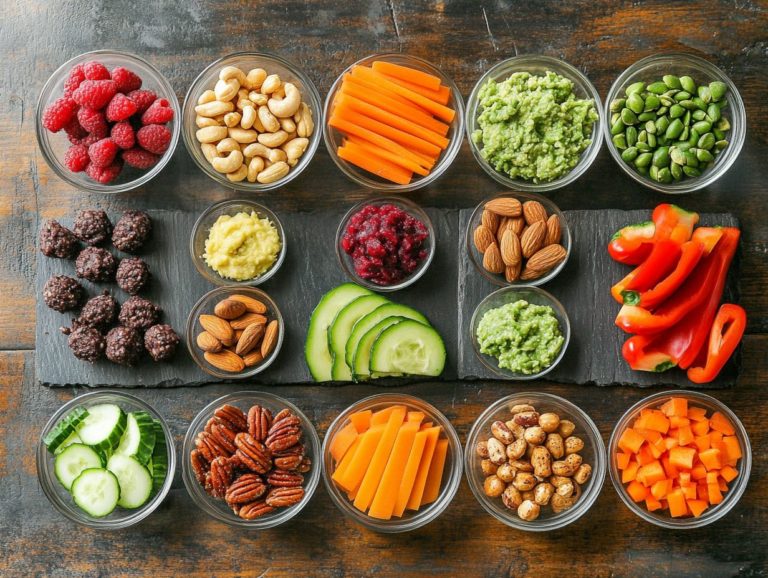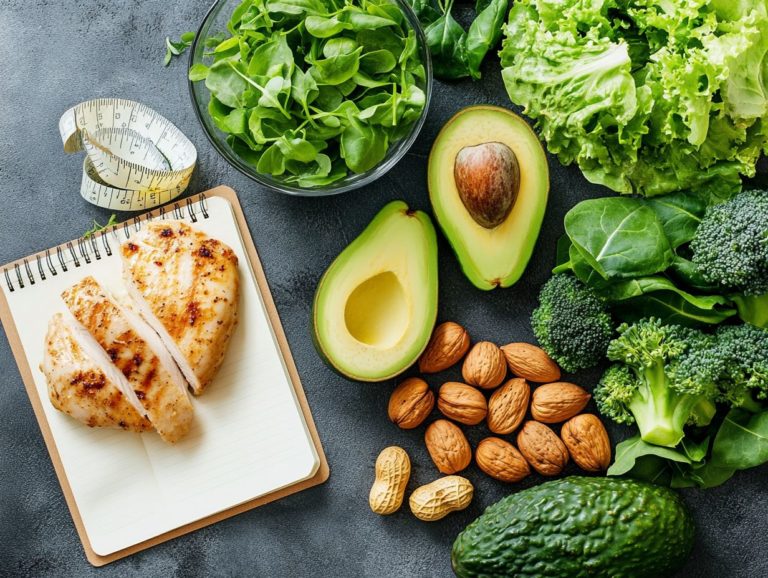Keto Diet: Benefits, Risks, and Meal Ideas
The Keto Diet is taking the health world by storm! With its unique approach to weight loss and wellness, it s capturing the attention of many. By transitioning your body’s metabolism to draw energy from fats rather than carbohydrates, this low-carb, high-fat regimen offers a wealth of benefits, from enhanced energy levels to potential health improvements.
Like any dietary plan, it presents its own set of challenges and risks that you should be aware of. This article will delve into the principles of the Keto Diet, equip you with meal planning guidance, and present an array of delicious recipe ideas to keep you on track.
Whether you’re merely curious or poised to embark on your Keto journey, you ll uncover valuable insights and tips to help you thrive. Start your Keto journey today and discover how you can transform your health!
Contents
- Key Takeaways:
- What is the Keto Diet?
- Benefits of the Keto Diet
- How to Follow the Keto Diet
- Keto-Friendly Meal Ideas
- Tips for Success on the Keto Diet
- Frequently Asked Questions
- What is the Keto Diet and What Are Its Benefits?
- What Are the Risks Associated with the Keto Diet?
- Can the Keto Diet Be Beneficial for Individuals with Certain Health Conditions?
- What Are Some Meal Ideas for the Keto Diet?
- Is It Necessary to Track Macros on the Keto Diet?
- Can the Keto Diet Be Maintained Long-Term?
Key Takeaways:

The Keto Diet is a low-carb, high-fat eating plan that shifts your body into ketosis, using fat for energy instead of carbs.
This diet can help with weight loss and blood sugar control but may lead to nutrient deficiencies and symptoms like the keto flu.
Focus on healthy fats, proteins, and low-carb veggies while cutting out processed foods.
What is the Keto Diet?
The Keto Diet, or ketogenic diet, is a low-carb, high-fat approach designed to usher your body into a metabolic state known as ketosis.
In this state, your body transitions from burning carbohydrates to primarily utilizing fats for energy. Many people pursue this dietary shift for various health objectives, such as substantial weight loss and enhanced metabolic health.
It requires careful planning and sticking to certain dietary rules. Consulting with a clinical dietitian can offer you personalized dietary guidance, making your transition into this lifestyle both informed and effective.
Overview and Principles
The principles of the ketogenic diet center around a high fat intake while dramatically cutting down on carbohydrates to induce a state of ketosis. This metabolic shift can offer a range of health benefits, including better blood sugar control and effective weight loss.
In this state, your body transitions its primary energy source from glucose to fat, which fundamentally changes how it processes fuel.
To successfully embrace this approach, aim for a ratio of roughly 70-75% healthy fats, 20-25% protein, and a mere 5-10% carbohydrates.
Incorporating healthy fats think avocados, olive oil, and nuts is essential, while opting for lean protein sources like grass-fed meats and fish will provide vital nutrients without causing insulin spikes.
By adhering to these ratios and gradually cutting back on carbohydrates, you can achieve metabolic adaptation, boosting fat oxidation and promoting sustainable weight loss. These foundational principles help curb cravings and stabilize your energy levels, making the ketogenic diet a powerful ally in your weight management journey.
Benefits of the Keto Diet
The Keto Diet offers impressive benefits like weight loss and better diabetes management. Weigh these advantages against potential risks, including nutrient deficiencies.
Health Improvements and Potential Risks
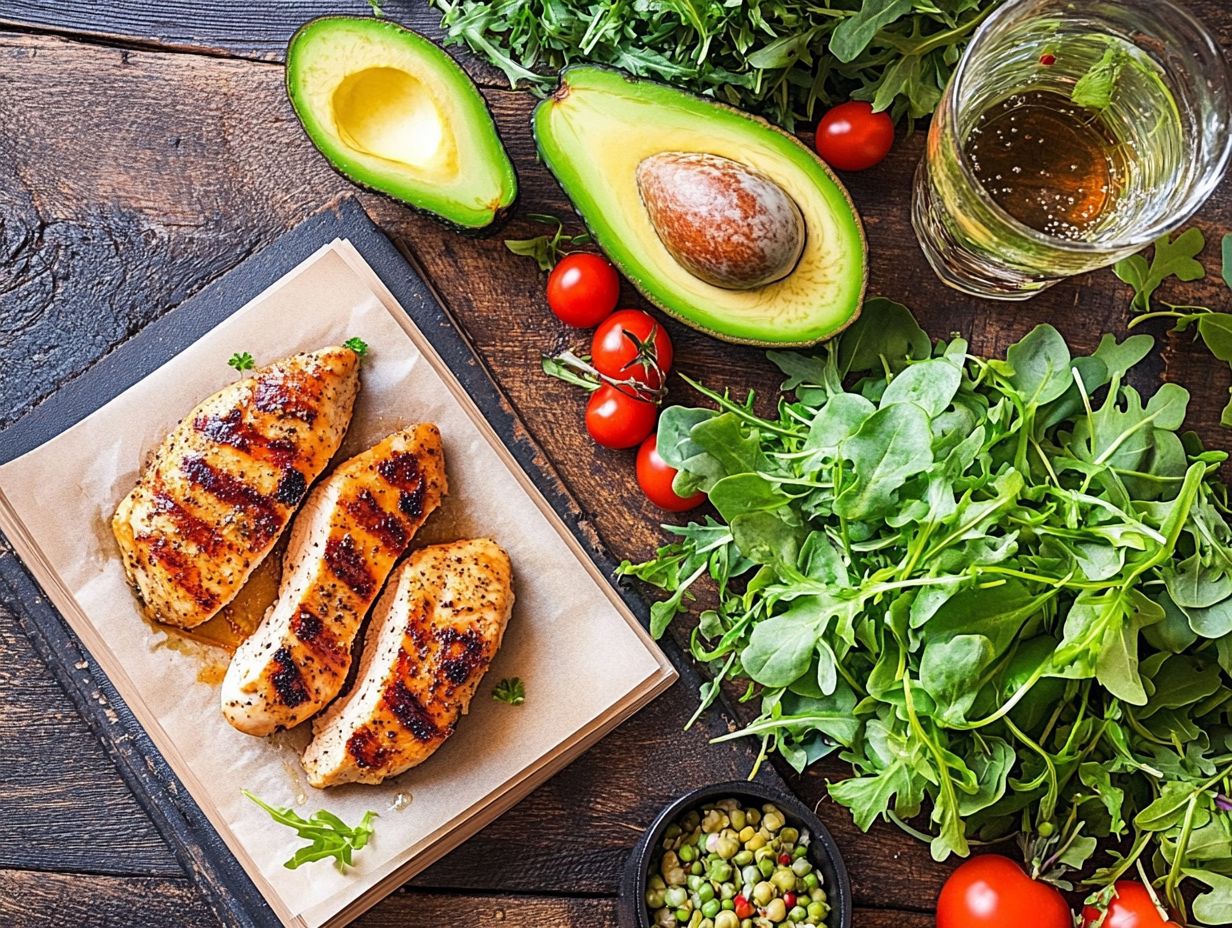
While the keto diet can offer substantial health benefits, such as weight loss and improved blood sugar regulation, it’s important to stay mindful of potential side effects, including the dreaded keto flu. Keto flu refers to flu-like symptoms that some people experience when starting the keto diet. You should also consider dietary safety concerns regarding saturated fats versus the necessity of omega-3 fats.
The keto flu often shows up as fatigue, headaches, irritability, and nausea. These symptoms can present quite the challenge for those new to this low-carb lifestyle. Ensuring a balanced intake of nutrients is essential, as deficiencies can worsen these symptoms.
Start using omega-3s now to fight inflammation and feel your best! Incorporating omega-3 fatty acids into your diet can significantly reduce inflammation, a common issue when embracing high-fat diets. Clinical research underscores the critical role of omega-3s in supporting heart health and cognitive function especially vital during dietary transitions.
To navigate potential health concerns effectively, keep your electrolyte levels in check, stay well-hydrated, and gradually adjust to lower carbohydrate intake while prioritizing healthy fat sources.
How to Follow the Keto Diet
Embracing the keto diet means crafting a well-structured dietary plan that highlights keto-friendly foods. This approach emphasizes high fats, moderate proteins, and low carbohydrates, allowing you to maintain healthy eating habits while fully committing to the diet.
Meal Planning and Guidelines
Meal planning for the keto diet can be fun and creative! It should incorporate low-carb vegetables, indulgent fat bombs, and delightful ingredients like unsweetened chocolate, coconut oil, and keto coffee. This approach ensures you stay on track with your dietary goals while savoring nutritious meals.
By carefully selecting your ingredients, you can create a diverse menu that meets low-carb requirements while tantalizing your taste buds. Picture vibrant salads filled with fresh spinach, peppery arugula, and roasted Brussels sprouts; these can serve as hearty sides or the perfect base for your main dishes.
Don’t shy away from experimentation try roasting, grilling, or stir-frying proteins like succulent chicken thighs or rich salmon. This adds layers of flavor that truly enhance your dining experience.
And let’s not forget about snacks! Pairing creamy guacamole with crisp bell pepper slices or crunchy cheese crisps can keep your energy levels high throughout the day, all while staying firmly within keto principles.
Keto-Friendly Meal Ideas
Keto-friendly meal ideas offer an exquisite array of delectable choices for breakfast, lunch, dinner, and snacks, all meticulously crafted to align with your dietary needs.
These options highlight the significance of healthy fats while keeping carbohydrates to a minimum. You can enjoy every bite without compromising your nutritional goals.
Breakfast, Lunch, Dinner, and Snack Options

For keto-friendly breakfasts, you can’t go wrong with options like avocado eggs and chia seed pudding to kickstart your day.
Regarding lunch, think salads dressed with rich, high-fat dressings paired with grilled chicken to keep your energy levels soaring throughout the day.
As you plan your dinners, consider incorporating zucchini noodles topped with pesto and shrimp; it adds delightful variety while keeping you aligned with your dietary goals.
For snacks, reach for some nuts or cheese crisps they deliver that satisfying crunch without compromising on nutritional value.
Maintaining healthy eating patterns is essential, as they support weight management and boost your overall well-being.
By enjoying a medley of flavors, whether in savory dishes or sweet snacks, you ensure that your journey toward a healthier lifestyle stays enjoyable and sustainable.
Tips for Success on the Keto Diet
Successfully navigating the keto diet demands more than just changing your eating habits; it involves implementing effective strategies to surmount challenges and maintain your motivation. This ensures that you remain steadfast in your commitment to achieving your weight management goals.
Ready to dive into delicious keto meal planning? Start experimenting with these ideas today and share your favorite recipes!
Overcoming Challenges and Staying Motivated
Overcoming challenges like keto flu and maintaining accountability through support groups can significantly enhance your experience on the keto diet. This fosters healthy habits that encourage long-term adherence.
To manage the symptoms of keto flu, stay hydrated and replenish electrolytes with foods rich in potassium, magnesium, and sodium. Seeking dietary advice from healthcare professionals provides tailored strategies that align with your lifestyle, making the transition smoother.
Joining support groups, whether online or in person, offers a valuable platform for sharing experiences, recipes, and encouragement. This helps you feel less isolated on your journey.
By cultivating healthy habits and actively seeking guidance, you can achieve not just temporary success but a sustainable lifestyle change that lasts well beyond the initial phases of the diet.
Frequently Asked Questions
What is the Keto Diet and What Are Its Benefits?
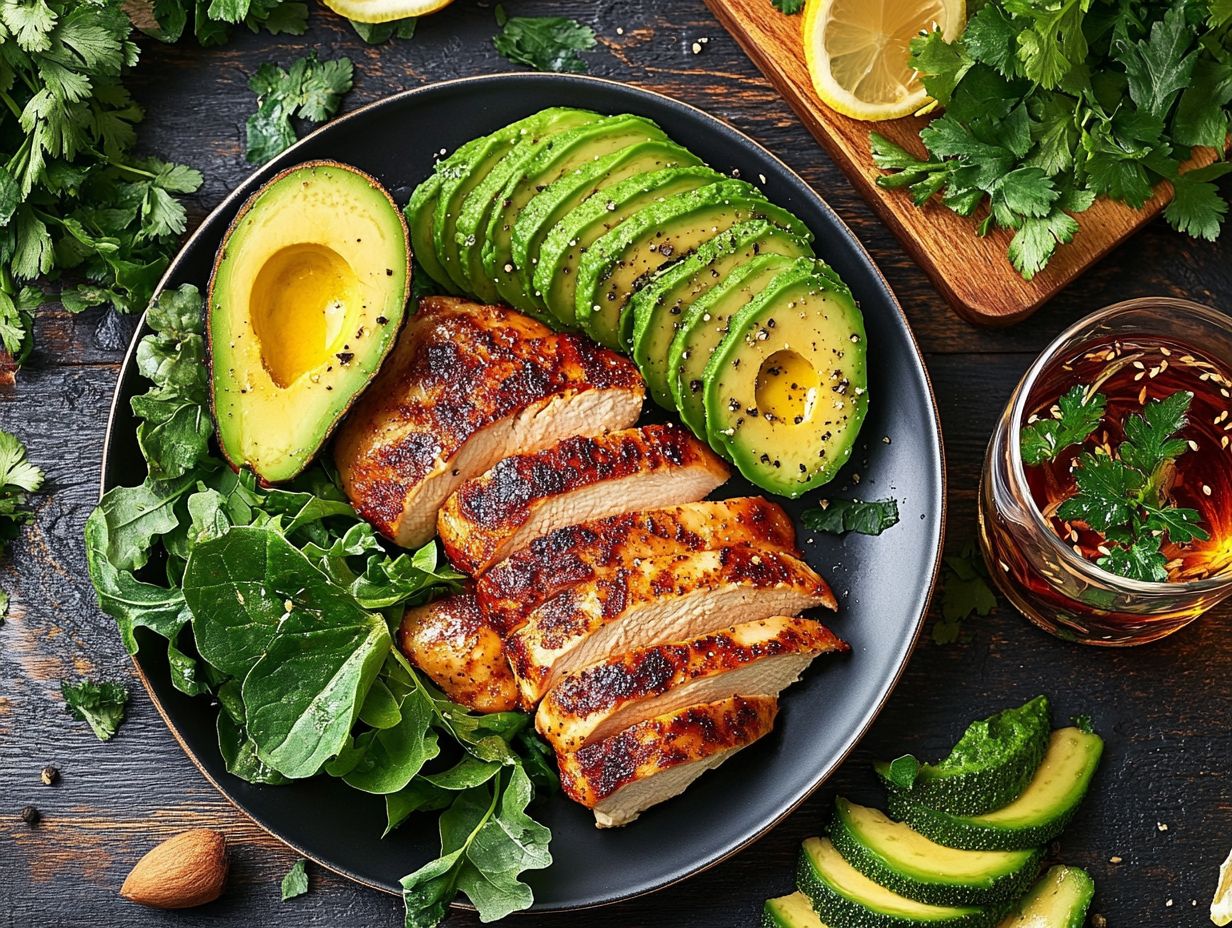
The Keto Diet is a low-carbohydrate, high-fat diet that puts your body in a state called ketosis. In this state, your body burns fat for energy instead of glucose. Some benefits include:
- Weight loss
- Improved blood sugar control
- Increased mental clarity and energy
What Are the Risks Associated with the Keto Diet?
While the Keto Diet is generally safe, it may not suit everyone. Potential risks include:
- Nutrient deficiencies
- Digestive issues
- The “keto flu” during the initial transition
Consult a healthcare professional before starting any new diet.
Can the Keto Diet Be Beneficial for Individuals with Certain Health Conditions?
Yes, the Keto Diet may benefit individuals with conditions like epilepsy, PCOS, and Type 2 diabetes. Always consult your doctor to ensure it s safe and suitable for you.
What Are Some Meal Ideas for the Keto Diet?
Here are some delicious meal ideas for the Keto Diet:
- Breakfast: Avocado and eggs
- Lunch: Chicken salad with avocado and olive oil
- Dinner: Salmon with roasted vegetables
- Snacks: Nuts, cheese, and low-carb veggies like celery and cucumber
Is It Necessary to Track Macros on the Keto Diet?
Tracking macronutrients (macros) is crucial on the Keto Diet. It helps keep your body in ketosis. Aim to:
- Keep carb intake under 50 grams per day
- Balance healthy fats and moderate protein
Can the Keto Diet Be Maintained Long-Term?
The Keto Diet can be maintained long-term if done healthily. Focus on:
- Eating whole, nutritious foods
- Seeking guidance from healthcare professionals or registered dietitians
This ensures adequate nutrient intake and overall health.
Have questions or want to share your experiences? Join our community for support and more tips!


